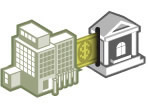Be Careful Not To Exceed 6 ACH Transfers On Your Savings Account Per Month
Published 12/29/07 (Modified 4/9/15)
By MoneyBlueBook
 I was routinely checking my Citibank balance online the other day when I noticed a little warning box above my account balance mentioning something about a savings account transfer limit of 6 per statement cycle imposed by a federal rule called Regulation D. I had heard about it before but never previously paid it much attention. Examining the reminder message, it was clear to me that this was something that might easily be overlooked by the average savings account holder. It's the type of important information that should be, but isn't readily advertised enough by banks. Particularly at this stage of the current ongoing economic crisis as high interest savings accounts continue to rapidly grow in popularity, it's more important than ever to be mindful of the transactional limitations of such accounts. Your money may be earning the highest interest rates at the top savings banks, but the trade off is a reduction in liquidity and access to funds.
I was routinely checking my Citibank balance online the other day when I noticed a little warning box above my account balance mentioning something about a savings account transfer limit of 6 per statement cycle imposed by a federal rule called Regulation D. I had heard about it before but never previously paid it much attention. Examining the reminder message, it was clear to me that this was something that might easily be overlooked by the average savings account holder. It's the type of important information that should be, but isn't readily advertised enough by banks. Particularly at this stage of the current ongoing economic crisis as high interest savings accounts continue to rapidly grow in popularity, it's more important than ever to be mindful of the transactional limitations of such accounts. Your money may be earning the highest interest rates at the top savings banks, but the trade off is a reduction in liquidity and access to funds.
Banks Place A Limit On The Number of ACH Transactions You May Execute Per Month
Bank savings and money market accounts are regulated by the Federal Reserve Board's Regulation D, which governs deposit accounts and their reserve requirements. The reserve percentage is the amount mandated by federal law that banks must retain in house and not loan out to customers. For savings and money market deposit accounts, Regulation D limits the number of electronic ACH transfers that one can make to 6 per statement cycle, which is about a month. While the regulation doesn't impose a reserve requirement for savings and money market accounts, it does impose about a 10% reserve requirement for checking accounts. Because checking accounts are utilized more frequently, the reserve requirement is to ensure that banks can meet demand and not run out of money. Because savings accounts are not subject to the reserve, the transaction limit helps to keep deposit withdrawals to a minimum.
In the past, before the popularity of online banks such as FNBO Direct and ING Direct, this was less of a problem since bank customers usually visited their local brick and mortar branch to request bank transfers. Now, with the growing popularity of online banks and the emergence of interest rate chasers, customers are starting to hit or exceed their ACH limit with greater regularity. Every bank enforces Regulation D requirements differently. One time violations of the monthly limit will usually result in finance charges or refusals to process the excess request, but frequent violations may cause your bank savings account to be closed and terminated, with the balance transferred to your checking account or sent to you in the form of a check.
Transactions That Count Towards the 6 ACH Transaction Limit Include:
- Online transfers from savings to a linked account (such as checking)
- Outgoing online transfers made to another bank through ACH or via online wire transfers
- Transfers made via phone banking
- Pre-authorized deductions by a third party
- Checks written from a money market account
However, Transactions That DO NOT Affect Your Limit Include:
- Transfers and deposits into a savings or money market account
- Withdrawals and transfers made at an ATM machine
- Withdrawals and transfers made in a bank branch via a teller
A Few Possible Solutions To Get Around The Limit
Because banks don't usually track and display your remaining limit for you on their websites, other than manually doing it yourself, another solution is to forgo the FDIC insurance benefits of savings accounts altogether and deposit your savings into a money market fund through a brokerage firm instead. There are usually no caps on the number of transactions you can make with money market funds, although some funds do impose minimum limits on the amount you can withdrawal at one time, as well as waiting periods for withdrawals. While money market funds are more akin to stock investments and theoretically involve a bit more risk, the interest yields are usually much higher than that offered by ordinary savings accounts. But if you want complete flexibility and liquid access to your money, perhaps you should just stick with plain old checking accounts. There are no restrictions with checking accounts, although the interest yields are usually low to none.
January 1, 1970 at 12:00 am